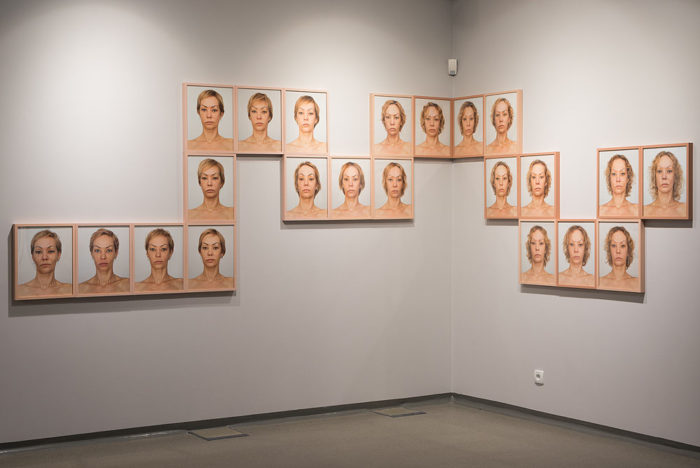Agata Zbylut
PLN 28,700

Undergoing the successive treatments documented as part of the project Mommy, I also took a picture of my face after it had already healed, i.e. when the money spent should have produced a visible effect. The pictures show only the face and emulate the convention that Roman Opałka employed in his practice when he showed his “counted paintings” next to his self-portraits. Earlier I often wondered how he worked. It seemed monotonous – entering the studio like a factory floor and going through the same moves every day. But at some point I realized that the detached, conceptual counting-off of passing time was a personal and emotional drama when you added a human face to the numbers. A face that ages and passes away. The successive numbers measure off not the end of the world, but the end of the individual. The fading background in the paintings corresponds with the artist’s greying hair, completely white towards the end of his life. They reflect the ever more insignificant pleasures and abilities that the body still has to offer, and the ever greater problems that are an inevitable part of growing old. So I also added numbers to my self-portrait photos. Those are costs of the different procedures, which as of today add up to 28,700 Polish zlotys. Every time I show the work, the figure in the title will be updated. Each of the photographs also has its own title, showing the cost of the given procedure. Instead of counting off passing time, I record a struggle to arrest its flow. The dream of finding the fountain of youth, so frequent in folk tales, is today repeated like a mantra in youth clinics, beauty parlours, and even at the dentist’s.
Producing the successive paintings, Opałka gained in significance, and his standing of a successful man, his prestige, grew. Photographing my own face and labelling it with absurdly high costs, I expose my own image to ridicule. My so called common sense loses. Instead of a heroic, utilitarian struggle with time, there is a woman’s petty drama and the charge of being unable to “grow old with dignity.” “Money thrown down the drain,” we think, but do we have such thoughts when the money is spent on male pleasures: electronics, a new car? We envy them their luxury goods, even if the previous car was still fine. But a woman who has spent nearly thirty thousand on her face? Pathetic.
I began this project two years ago and I don’t know how long it will continue. Perhaps as long as I live.
Agata Zbylut
– Agata Zbylut, PLN 28,700, 2018-2020, pigment ink, cotton paper, 23 prints, 40 × 32 cm each, audio recording (loop), courtesy of the artist
Agata Zbylut, PhD Hab., is an academic, artist, feminist, and radicalizing vegetarian, occasionally also curator and activist. In 2000-2005, curator of Amfilada Gallery. In 2004, she coordinated the “Signs of Time” National Culture Programme in the West Pomeranian Voivodship. Awarded the Gloria Artist Brown Medal for Merit to Culture (2005). In 2004, she founded the Association for the Encouragement of Contemporary Art in Szczecin [Stowarzyszenie Zachęta Sztuki Współczesnej], which she has since served as president of and which has meanwhile built the Regional Collection of Contemporary Art, the largest of its kind in north-western Poland, as well as establishing the Trafostacja Sztuki art space in Szczecin. Originator and curator of the “Draft” Festival of Young Art (2007, 2009, 2011). She has worked at the Art Academy in Szczecin since 2010 (promoted to Associate Professor in 2013), running the Photography and Postartistic Practices Studio and, since 2018, also as as Chair of Photography. She has participated in over a a hundred solo and group exhibitions in Poland, Germany, Russia, Ukraine, France, Croatia, Great Britain, and the United States. She lives and works in Warsaw and Szczecin.
Her primary format is self-portrait. As she writes herself, “My statement is the statement of a woman who obsessively watches other women: how they live, what choices they make, their emotions, the cultural, sociological, and legal conditions they face. I notice the inequalities they struggle with, how they are hindered from the start, have to overcome many obstacles, and it is hard for them to get where in a male physical and cultural body they would get easily. What interests me in particular are women’s relationships with their own bodies, how they succumb to the ‘beauty myth,’ and how experience and life wisdom wrestle with aesthetic standard-eluding bodies.”